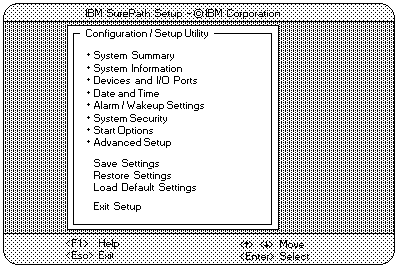
Configuration/Setup utility program menus

Pressing F1 displays Help information for a selected menu item.
In the Configuration/Setup Utility program menus, you can accept the configuration changes by viewing and saving
the changes, or you can make manual changes and then save the settings.
The following is a quick reference for identifying symbols in the Configuration/Setup Utility program.
To exit from the Configuration/Setup Utility program:
Please see the LEGAL - Trademark notice.
Use the following commands to navigate through the screens and make selections:
Key
Function


Move between menu items.
< >
Toggle between choices for a menu item.
Enter
Select an item.
Esc
Exit from a menu after viewing or making changes.
F1
Get help on a selected menu item.
System Summary: Select this choice to display configuration information,
such as the type and speed of the microprocessor, and the amount of memory.
Changes that you make to configuration settings appear on this summary screen.
You cannot edit the fields on this screen. If you need to change the configuration settings,
you must make the changes from the applicable menu choices.
Product Data: Select this choice to view the machine type and model,
the system serial number, the system board identifier, and the revision level, issue date,
or BIOS Mode of the flash EEPROM (BIOS).
Devices and I/O Ports: Software recognizes ports from their port assignments.
Each port must have a unique port assignment. The Configuration/Setup Utility program normally handles this,
but you might have special hardware or software that requires you to change these assignments.
Select the Devices and I/O Ports choice to view or change the assignments for devices and input/output ports.
You can add serial ports by installing a serial adapter in an expansion slot.
See the documentation that comes with the serial adapter for information about port assignments.
To display or change the port assignments:
Start Options: Select this choice to view and change settings for device startup sequence,
keyboard speed, virus detection, various power-on options, and other features.
You can control the startup sequence of the devices in the server.
Each time that you power-on the server, it checks the devices as it looks for the operating system.
The order in which the system checks the devices is the device-startup sequence.
Note:
The default startup sequence is:
To set the startup sequence:
To set the power-on status:
Date and Time: Select this choice to set the system date and time.
The system time is in a 24-hour format: hour/minute/second.
The system date is in standard format for your country or region.
For example, in the United States, the format is MM/DD/YYYY (Month/Day/Year).
To set the date and time:
Back to ![]()
Feel free - send a  for any BUG on this page found - Thank you.
for any BUG on this page found - Thank you.